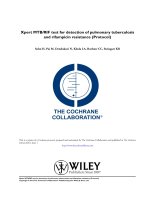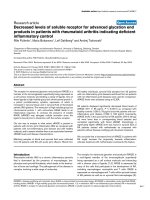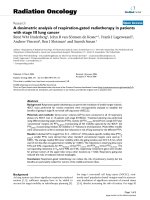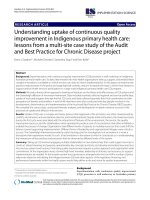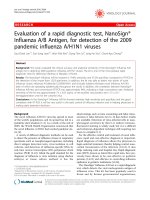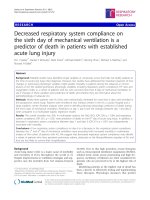Establishing a molecular protocol for detection of EGFR mutations in patients with non-small cell lung cancer
Bạn đang xem bản rút gọn của tài liệu. Xem và tải ngay bản đầy đủ của tài liệu tại đây (1.27 MB, 8 trang )
Life Sciences | Medicine, Biotechnology
Doi: 10.31276/VJSTE.60(4).31-38
Establishing a molecular protocol for detection
of EGFR mutations in patients with
non-small cell lung cancer
Thi Minh Ly Nguyen1,2*, Quoc Dang Quan3, Thi Bach Hue Nguyen2, Hoang Chuong Nguyen2
1
Gentis Joint Stock Company
University of Science, Vietnam National University, Ho Chi Minh city
3
Center of Science and Technology Development, Ho Chi Minh Communist Youth Union
2
Received 23 April 2018; accepted 28 September 2018
Abstract:
Lung cancer is one of the quickest and most fatal diseases and is divided into two types: small cell lung cancer
(SCLC) and non-small cell lung cancer (NSCLC). Approximately 50% of NSCLC patients harbour mutations in
the epidermal growth factor receptor (EGFR) gene, spanning from exon 18 to exon 21, which are responsible for
the tyrosine kinase domain of the EGFR protein. Currently, gefitinib and erlotinib are two drugs inhibiting EGFR
which are used in the treatment of lung cancer. The indication for use of these drugs depends on the mutation
status of EGFR. Resistance to treatment with these two drugs has been found with mutations in exon 20; however,
mutations in exon 18, 19, 21 benefited from the same treatment. Therefore, we built a molecular protocol for
detecting mutations in exon 21 of EGFR in NSCLC patients in Vietnam which, in this study, is based on the realtime polymerase chain reaction high resolution melting (PCR HRM) technique. We successfully designed pairs
of primers for the real-time PCR HRM technique to detect mutations in exon 21 and for the Sanger sequencing
method to confirm the real-time PCR HRM results. We also investigated the optimal concentration of MgCl2
for the real-time PCR HRM protocol. Performance characteristics of the real-time PCR HRM protocol were
evaluated in terms of specificity, limit of detection, repeatability, and it showed good results. Finally, we applied the
molecular protocol to 172 clinical samples and compared these with the Sanger nucleotide sequencing method and
the peptide nucleic acid (PNA) clamping method. The results of the comparison demonstrate that the molecular
protocol constructed for detection of exon 21 mutations can be used in the treatment of NSCLC patients.
Keywords: EGFR, exon 21, mutations, PNA Clamp.
Classification numbers: 3.2, 3.5
Introduction
Lung cancer is the leading cause of cancer mortality
worldwide. This is especially the case in Vietnam. Lung
cancer comprises two types: NSCLC, which accounts for
approximately 80-85% of lung cancer patients, and SCLC,
which accounts for approximately 15-20% of lung cancer
patients [1]. NSCLC has a poor prognosis if it is diagnosed
at an advanced stage.
EGFR is a member of the ErbB receptor tyrosine kinase
family; it has an extracellular ligand-binding domain,
a transmembrane domain, and an intracellular tyrosine
kinase. EGFR (also called ErbB1, Her1) is a transmembrane
receptor tyrosine kinase that transduces signals that are
critical for cell proliferation, differentiation, and apoptosis
[2]. Overexpression of EGFR has been observed in tumours
in more than 60% of metastatic NSCLC patients and is
correlated with a poor prognosis [3]. Overexpression
or mutational activation of EGFR is associated with
the development and progression of numerous human
malignancies. Drugs as tyrosine kinase inhibitors (TKIs)
that target the ATP-binding cleft of EGFR have been
developed for the treatment of NSCLC patients with EGFR
mutations [4].
EGFR is located on chromosome 7 at the 7p12 locus
and it is in the proto-oncogene group. EGFR is 110 kb long,
comprising 28 exons [5]. EGFR mutations associated with
*Corresponding author: Email:
December 2018 • Vol.60 Number 4
Vietnam Journal of Science,
Technology and Engineering
31
Life Sciences | Medicine, Biotechnology
NSCLC belong to four exons, from 18 to 21. Mutations in
EGFR cause the EGFR protein to exist in a non-ligandactivated state that increases the sensitivity of the tumour or
resistance to EGFR TKIs.
In the last few years, EGFR receptor inhibitor drugs
such as erlotinib (Tarceva) and gefitinib (Iressa) have been
used for the treatment of NSCLC and have been shown
to have encouraging effects [6]. These two drugs inhibit
EGFR autophosphorylation by inhibiting ATP binding to
EGFR and reducing the affinity between EGFR and its
ligand. Patients treated with gefitinib and erlotinib show
good progression, such as significant tumour size reduction,
longer life duration, and fewer side effects than conventional
chemotherapy or radiation. The level of treatment response
to the drug depends on the presence or absence of mutations
in EGFR; patients should be tested for EGFR mutations
prior to the administration of targeted therapies.
It has been reported that the frequency of EGFR mutations
in NSCLC patients is dependent on ethnicity, with a rate of
54.1% found in Asian populations [7]. Vietnam is one of the
countries with a high rate of EGFR mutations and therefore
EGFR mutation assessment before treatment is essential
for successful treatment. In Vietnam, EGFR mutations
are detected using Sanger sequencing or commercialized
molecular kits. The sequencing method is not appropriate
to detect gene mutations with a low frequency. On the other
hand, commercialized kits are expensive and involve a
complicated process. For example, the PNA clamping kit
costs 70,000,000 VND for 50 reactions (about 1,400,000
VND per reaction), while the chemical reagents for the
real-time PCR HRM assay cost approximately 120,000
VND per reaction. According to the manual, ‘PNAClamp™
EGFR Mutation Detection Kit Ver. 2’, the PNA clamping
kit involves a complicated process. Real-time PCR HRM is
a powerful technique in molecular biology for the detection
of mutations, polymorphisms, and epigenetic differences
in double-stranded DNA samples [8]. It is a simple, quick,
and accurate method for detecting genetic modifications. In
addition, it is more cost effective than other methods such as
nucleotide sequencing, real-time PCR with Taqman probes,
and DNA hybridization techniques with specific probes.
However, it requires that the primer pair be well-designed
so that homologous DNAs that differ in terms of only one
nucleotide can be differentiated by melting curves. For
these reasons, we established a molecular protocol based
on the real-time PCR HRM technique to detect mutations
in EGFR’s exon 21. This protocol will be useful for the
treatment with gefitinib and erlotinib of NSCLC patients
bearing EGFR mutations.
32
Vietnam Journal of Science,
Technology and Engineering
Materials and methods
Samples
A total of 172 lung cancer biopsy specimens was
collected from Hanoi Oncology Hospital and Cho Ray
Hospital. These patients were recommended for EGFR
mutation testing by physicians due to clinical features
associated with EGFR mutations. Of the 172 samples, 140
were diagnosed as being adenocarcinoma, and 32 were of
other or unknown histology. The tissues were stained using
the hematoxylin-eosin (HE) method. The tumour-rich areas
were identified by geneticists with the aid of a microscope
to ensure that sufficient material was available for the realtime PCR HRM assay. The bacterial strains, including
Klebsiella pneumoniae, Pseudomonas aeruginosa, and
Staphylococcus aureus were provided by Gia Dinh People’s
Hospital.
Reagents
All the chemical reagents for DNA extraction, PCR,
real-time PCR HRM, and agarose gel electrophoresis were
purchased from Qiagen, Kapa Biosystems, Merck, and
Sigma. The nucleotide sequencing kit was supplied by
Applied Biosystems. The primers were synthesized and
supplied by Phu Sa Biochem. The PNAClampTM EGFR
Mutation Detection kit Ver. 2 was purchased from Panagene,
Korea.
DNA extraction from
embedded (FFPE) tissue
formalin-fixed
paraffin-
The biopsy specimen was fixed with formalin and was
embedded in paraffin. The specimens were then stained with
HE dye and examined under a microscope. The location of
the suspected cancer cells was zoned and compared to the
cell region on the tissue. A sharp knife was used to cut the
tumour-rich areas, including a portion of the surrounding
cells. The tissue was washed several times in xylene to
dissolve the paraffin wax and then the xylene was removed
by washing the tissue several times with ethanol before
DNA was extracted. Genomic DNA was extracted using
the QIAamp DNA FFPE Tissue kit (Qiagen, Germany)
according to the manufacturer’s protocol. The extracted
DNA was then checked by means of the spectrophotometry
method and maintained at 4°C until use.
Design of the HRM primers
In order to ensure the best performance for mutation
detection using HRM, primer pairs were designed to create
PCR products with sizes ranging from 50 to 120 bp. The
primers were designed with Primer3Plus software. Each
amplicon was analyzed using Umelt software online to
ensure that it contained only a single melting peak. The
primers were checked with OligoAnalyzer software and the
Blast tool for their in-silico performance characteristics.
December 2018 • Vol.60 Number 4
Life Sciences | Medicine, Biotechnology
HRM assays
The real-time PCR HRM reaction was performed in
a 48-well Eco Plate on the EcoTM Real-time PCR system
(Illumina, USA). The 20 μl final volume of the reaction
mixture contained: 1X KAPA HRM Fast Master mix, 3 mM
MgCl2, 100 nM of 21F1, 100 nM of 21R1, 10 ng of genomic
DNA, and PCR-grade water. The KAPA HRM Fast Master
mix contained an optimized concentration of EvaGreen dye
and a highly engineered version of Taq DNA polymerase.
The cycling and melting conditions were as follows: one
cycle at 95°C for 3 min; 45 cycles at 95°C for 30s, 66°C for
30s, one cycle of 95°C for 1 min, and a melt from 70°C to
95°C, rising 0.2°C per second. HRM analysis was performed
using Eco Software (Ver. 4.1). The normalized graph and
the difference graph were used to analyze the data.
DNA sequencing
The amplification reaction of the PCR product for
nucleotide sequencing contained the following components:
1X KAPA 2G master mix, 3.5 mM MgCl2, 500 nM of 21F2
and 21R2, 30-50 ng of genomic DNA (if possible), and
PCR-grade water. The PCR reaction was performed using
the following conditions: initial denaturation at 95°C for 5
min; 40 cycles at 95°C for 20s, 60°C for 30s, 72°C for 30s,
and one cycle at 72°C for 7 min.
The PCR product was generated by means of agarose
gel electrophoresis. The band of interest was then cut into
the 1.5 ml eppendorf to prepare the DNA purification. The
PCR products were purified using the Zymo Gel Recovery
kit (Zymo Research, USA). Next, the purified product was
sequenced using the Big Dye Terminator v3.1 kit (Applied
Biosystems, USA), in accordance with the kit manual. Following the Big Dye reaction, the product was cleaned with
a sequencing clean kit. The sequencing products were run
on a 3100 Genetic Analyzer (Applied Biosystems). The
sequencing data was visualized using sequencing analysis
v5.3.
PNA Clamp
All samples were set up using the PNAClampTM EGFR
Mutation Detection kit (Ver. 2, Panagene, Korea). These
samples were set up according to the manufacturer’s
instructions. The PNA Clamp data was visualized using
7500 software Ver. 2.3.
Results
Identification of the target DNA sequence of exon 21
of EGFR
Exon 21 of EGFR encodes the tyrosine kinase region
of EGFR; its length is 156 bp. The sequence of exon 21
was loaded from GenBank and in Fig. 1, it is shown which
mutations (if any) occur in codon L858R and codon L861Q.
Fig. 1. The exon 21 sequence loaded from GenBank. The two
nucleotides t, in bold, occur from left to right at codon 858 and
codon 861.
Oligonuclotide design
We designed the 21F1-21R1 primer pair for amplification
of exon 21 by means of real-time PCR HRM and the 21F221R2 primer pair for the nucleotide sequencing of this exon.
The nucleotide sequences of the primers were as follows:
21F1: 5’ CGC AGC ATG TCA AGA TCA CAG 3’ 21R1: 5’ GGT ATT CTT TCT CTT CCG CAC C 3’
21F2: 5’ TGG CAT GAA CAT GAC CCT GAA 3’ 21R2: 5’ CAG CCT GGT CCC TGG TGT C 3’
The 21F1-21R1 primer pair was designed to generate a
PCR product of 66 bp in size. The small size of 66 bp helps
to avoid other SNPs in the proximity of the L858R and
L861Q mutations. In contrast, the 21F2-21R2 primer pair
was designed to generate a PCR product of 295 bp which is
suitable for sequencing by means of the Sanger technique.
In the next step, we checked the technical parameters
of the primers such as Tm, % GC, and the free energy of
the secondary structures using OligoAnalyzer software. The
results are presented in Table 1.
Table 1. Technical parameters of the designed primers.
Parameters
Primer
21F1
21R1
21F2
21R2
Nucleotide
21
22
21
19
GC content (%)
52.4
50
47.6
68.4
Tm (oC)
56.5
55.6
56.9
60.6
Hairpin (kcal/mole)
0.04
1
-1.55
0.25
Self-dimer (kcal/mole)
-5.38
-4.41
-5.38
-3.55
Hetero-dimer (kcal/mole)
-5.12
-6.21
The results in Table 1 show that the four primers met
the specific requirements for working well in PCR. Finally,
we tested the theoretical specificity of these primers using
Blast software. The results show that the primers match the
human DNA in the EGFR gene on chromosome 7 (data not
shown).
In addition, using the Umelt software, we predicted the
melting curve of 21F1-21R1 primers for wild and mutant
forms (of both L858R and L861Q mutants). The melting
curve peaks were clearly separated at Tm levels from 0.2°C
to 0.7°C (data not shown). In conclusion, the designed
primers were suitable for the subsequent experiments.
December 2018 • Vol.60 Number 4
Vietnam Journal of Science,
Technology and Engineering
33
Life Sciences | Medicine, Biotechnology
Building the real-time PCR HRM for exon 21 EGFR
mutation detection
We set up a real-time PCR HRM reaction with the 21F121R1 primer pair on a few human DNA samples. All of
them were positive in the real-time PCR. When analyzed
by means of HRM, they showed different melting curves
corresponding to the L858R and L861Q muations, as shown
in Fig. 2.
3
1
2
4
Fig. 2. The real-time PCR HRM results of exon 21 mutation
detection. 1: the wild type, 2: the L858R heterozygous mutation,
3: the L858R homozygous mutation, 4: the L861Q heterozygous
mutation.
According to the prediction of the Umelt software, there
were four different melting curves which corresponded to
the expected curves of the wild type (curve 1), the L858R
heterozygous mutation (curve 2), the L858R homozygous
mutation (curve 3), and the L861Q heterozygous mutation
(curve 4). The expected curve of the L861 homozygous
mutation was not found in HRM results.
To verify the results of the real-time PCR HRM, we ran
Sanger nucleotide sequencing on these four samples. The
results of the nucleotide sequencing of the four samples are
shown in Fig. 3.
The nucleotide sequencing results show that there were
two peaks of thymine at codon 858 and codon 861 in the
wild-type sample. There were two peaks of guanine and
thymine at codon 858 in the L858R heterozygous mutation
sample. The L858R homozygous mutation sample had one
peak of guanine at codon 858. The L861Q heterozygous
mutation sample had one peak of adenine and thymine
at codon 861. Thus, the Sanger nucleotide sequencing
confirmed that the mutation detection results using realtime PCR HRM were correct.
With these four samples, we performed the optimization
of MgCl2 concentration for the real-time PCR HRM.
Thewildtypesam ple
The wild-type sample
m
utation
sam ple
hom
ozygous
The
w
ildtype
sam
ple
TheL858R
L858R The
homozygous
mutation
sample
TheL858Rheterozygousm utationsam ple
The L858R heterozygous mutation sample
m utation
sam ple
The
L861Q
heterozygous
The
L861Q
heterozygous
mutation
samplesam
The
wildtype
sam
ple
The
L858R
heterozygous
m utation
ple
Fig. 3. Results of the Sanger nucleotide sequencing of four samples of wild type, L858R heterozygous mutation, L858R homozygous
mutation, and L861Q heterozygous mutation.
34
Vietnam Journal of Science,
Technology and Engineering
December 2018 • Vol.60 Number 4
TheL85
Life Sciences | Medicine, Biotechnology
Fig. 4. Examination of the optimal MgCl2 concentration for the real-time PCR HRM. (A) 1.5 mM, (B) 2 mM, (C) 2.5 mM, and (D) 3 mM.
Optimization of MgCl2 concentration
MgCl2 is the major component that influences the
melting temperature of PCR products when analyzed
using HRM. Therefore, we examined the optimum MgCl2
concentration for distinguishing different melting curve
types corresponding to the mutations at codons 858 and 861
of exon 21. We investigated the MgCl2 concentrations of
1.5 mM, 2 mM, 2.5 mM, 3 mM, and 3.5 mM. The results of
the optimization of MgCl2 concentration are shown in Fig. 4.
The results in Fig. 4 show that the four melting curve genes
corresponding to the wild type, the L858R heterozygous
mutation, the L858R homozygous mutation, and the L861Q
heterozygous mutation were more clearly distinguished
when the MgCl2 concentrations were increased. At the
MgCl2 concentration of 3.5 mM, a negative control has an
amplified signal (data not shown). Thus, we selected the
MgCl2 concentration of 3 mM for the real-time PCR HRM.
21 of EGFR by means of the 21F1-21R1 primer pair. To
effect this, we first performed restriction enzyme analysis
of the PCR product of the 21F1-21R1 primer pair because
this PCR product is too small to be analyzed using Sanger
nucleotide sequencing. The restriction enzymes used in this
experiment were the MboI enzyme, which cuts the target
product into two fragments of 14 bp and 52 bp, and the
DpnI, which cuts the target product into two fragments of
16 bp and 50 bp. The results of the restriction anlysis are
shown in Fig. 5.
Analytical sepcificity of the real-time PCR HRM
protocol
Analytical specificity of the real-time PCR HRM
protocol was demonstrated by means of the selective
amplification of the human DNA region containing exon
Fig. 5. Restriction analysis of the PCR product of 21F1-21R1. M:
DNA ladder, 1: the untreated PCR product, 2: the PCR product
treated with MboI, 3: the PCR product treated with DpnI.
December 2018 • Vol.60 Number 4
Vietnam Journal of Science,
Technology and Engineering
35
Life Sciences | Medicine, Biotechnology
The results in Fig. 5 show that the restriction products from
the treatment of the 21F1-21R1 PCR product with MboI and DpnI
had the expected sizes when compared to the DNA ladder. DNA
bands of approximate 50 bp appeared in lane 2 and lane 3, while
the bands of 12 bp and 14 bp were too small and they were run
out of the gel. This result confirmed that the 21F1-21R1 amplified
the target region in exon 21 of EGFR containing the L858R and
L861Q mutations.
We also investigated the selective amplification of the 21F121R1 primer pair on the genetic material of various agents,
including human and human pathogenic bacteria (Klebsiella
pneumoniae, Pseudomonas aeruginosa, and Staphylococcus
aureus) in the real-time PCR. We selected these bacteria for the
selective amplification experiment because they can coexist in
humans as a result of infection and the total DNA extracted from
human samples can contain bacterial DNAs. The results of the
selective amplification of the 21F1-21R1 primer pair are presented
in Fig. 6.
Limit of detection of the HRM method
Most of the FFPE tissue samples of NSCLC cases obtained
for this study were small in size. Therefore, the amount of DNA
extracted from these samples were too small for analysis. To check
the limit of detection of the real-time PCR HRM protocol to detect
the L858R and L861Q mutations, we performed the real-time PCR
HRM on a range of amounts of DNA, from 1 to 15 ng, with four
samples of the wild-type sample, the L858R homozygous mutation
sample, the L858R heterozygous mutation sample, and the L861Q
heterozygous mutation sample. The results of the limit of detection
of the HRM method are shown in Table 2.
Table 2. Results of the limit of detection of the HRM method (in
four replicates).
Sample
1 ng
5 ng
7 ng
10 ng
15 ng
Detections (normal + mutation)/total run
The wild-type sample
4/4
4/4
4/4
4/4
4/4
The L858R homozygous
mutation sample
4/4
4/4
4/4
4/4
4/4
4/4
4/4
4/4
4/4
4/4
4/4
4/4
4/4
4/4
4/4
The L858R heterozygous
mutation sample
The L861Q heterozygous
mutation sample
The results in Table 2 show that the molecular protocol could
detect DNA concentrations at 1 ng. At 1 ng DNA levels, all the
samples were amplified and the melting curve analysis showed the
distinction between the wild type and mutant.
Repeatability
Fig. 6. Selective amplification of the 21F1-21R1 primer pair on
various genetic materials from humans and bacteria.
The results in Fig. 6 show that only the human DNA samples
generated a positive result in the real-time PCR reaction with the
21F1-21R1 primer pair; DNA samples from the bacteria produced
negative results in the reaction with the same primer pair. To
confirm that the negative results in the real-time PCR with the
21F1-21R1 primer pair on the bacterial DNA samples were truly
negative, we performed a PCR with the 8F-534R primer pair
on these DNA samples. This is a primer pair specific to the 16S
rRNA gene of all eubacteria. The results showed that the DNA
samples from Klebsiella pneumoniae, Pseudomonas aeruginosa,
and Staphylococcus aureus were positive for the PCR with the
8F-534R primer pair (data not shown). These results confirmed
that the negative results of the real-time PCR with the 21F1-21R1
primer pair on the bacterial DNA samples were truly negative.
Thus, the real-time PCR HRM protocol with the 21F1-21R1 primer
pair was specifically designed for the detection of the L858R and
L861Q mutations in exon 21 of EGFR.
36
Vietnam Journal of Science,
Technology and Engineering
We detected the mutations in exon 21 of EGFR using the realtime PCR HRM protocol on four samples of the wild-type sample,
the L858R homozygous mutation sample, the L858R heterozygous
mutation sample, and the L861Q heterozygous mutation sample
five times in the same experiment batch to measure the repeatability
of the protocol. The repeatability results were expressed by the
coefficient of variation (CV) and the CV values were calculated as
a percentage. The results are shown in Table 3.
Table 3. Repeatability calculation of the real-time PCR HRM for
exon 21 mutation detection.
Repeat
Wild-type
sample
L858R
homozygous
mutation sample
L858R
L861Q
heterozygous
heterozygous
mutation sample mutation sample
1
81
79.8
81.6
79.5
81.2
81.6
2
81.1
79.7
81.6
79.4
81.2
81.7
3
81.2
79.9
81.7
79.5
81.2
81.6
4
81.1
79.8
81.7
79.4
81
81.7
5
81.2
79.8
81.7
79.4
81.2
81.8
Average
81.13
79.80
81.66
79.44
81.16
81.68
Standard
deviation
0.08367
0.07071 0.05477 0.05477 0.0894
0.08367
% CV
0.00103
0.00089 0.00067 0.00069 0.0011
0.00102
Total % CV
0.00090
According to Table 3, the CV value of the repeatability test was
0.00090%. This CV proves the high precision of the real-time PCR
HRM protocol for the detection of mutations in exon 21 of EGFR.
December 2018 • Vol.60 Number 4
Life Sciences | Medicine, Biotechnology
Evaluating the real-time PCR HRM protocol on 172 human
DNA samples
We evaluated the performance of the real-time PCR HRM
protocol for detection of the mutations in exon 21 of EGFR on 172
human DNA samples which were provided by Hanoi Oncology
Hospital and Cho Ray Hospital. The detection of these mutations
was also performed using the Sanger nucleotide sequencing and
the PNAClampTM EGFR Mutation Detection kit. The results of
mutation detection in exon 21 of EGFR are shown in Table 4.
Table 4. Results of EGFR mutation detection by real-time PCR
HRM, nucleotide sequencing, and the PNA clamping method.
Results/methods
HRM
SEQ
PNA Clamp
L858R mutation
45
40
44
L861Q mutation
2
2
2
No mutation
125
126
124
Sample invalid/suspected
0
4
2
Total sample with results/total sample
172/172
168/172
170/172
HRM: high resolution melting; SEQ: sequencing; PNA Clamp:
peptide nucleic acid clamping.
The number of samples successfully analyzed by means of the
three methods were 172, 168, and 170 for the real-time PCR HRM
protocol, the Sanger nucleotide sequencing, and the PNAClampTM
EGFR Mutation Detection kit, respectively. In these 172 samples,
166 (96.5%) showed identical results for all three methods. The
real-time PCR HRM protocol detected 45 samples with the L858R
mutation while only 40 and 44 samples with this mutation were
detected by the Sanger nucleotide sequencing method and by the
PNAClampTM EGFR Mutation Detection kit, respectively. Six
cases that did not match among three methods were samples 19,
72, 24, 34, 171, and 172. The results of these samples using the
three methods are shown in Table 5.
Table 5. The results of the samples using the three methods.
Sample
HRM
GTT
PNA Clamp
19
Mutation L858R
heterozygous
Wild type
Mutation L858R
72
Mutation L858R
heterozygous
Wild type
Mutation L858R
24
Mutation L858R
heterozygous
Suspected wild type
Mutation L858R
34
Mutation L858R
heterozygous
Suspected wild type
Mutation L858R
171
Wild type
Invalid
Invalid
172
Mutation L858R
heterozygous
Invalid
Invalid
As can be seen in Table 5, the real-time PCR HRM protocol
and the PNAClampTM EGFR Mutation Detection kit produced
identical results for four samples (19, 72, 24, and 34) while
the Sanger nucleotide sequencing produced different results
for the same samples. Moreover, the real-time PCR HRM
protocol was successful for the last two samples (171 and 172)
while the PNAClampTM EGFR Mutation Detection kit and the
Sanger nucleotide sequencing produced invalid results. Further
experiments need to be conducted to confirm the results of these
six samples.
Discussion
The appearance of the targeted therapy made the cancer
treatment procedure more efficient and less toxic than traditional
radiotherapy/chemotherapy. Tyrosine kinase inhibitors of EGFR
are good examples of targeted therapy for NSCLC patients with
EGFR mutations. Among EGFR mutations, L858R and L861Q in
exon 21 were proven to confer selective sensitivity to treatment
with some TKIs such as erlotinib and gefitinib [6]. Thus, a
molecular protocol to detect these beneficial mutations would be
useful for the treatment of NSCLC patients with EGFR mutations.
With the L858R mutation, the leucine amino acid (L) is replaced
by the amino acid arginine (R), meaning that the nucleotide T is
replaced by the nucleotide G. Therefore, with L858R there will
theoretically be three forms: T/T (wild type), T/G (heterozygous),
and G/G (homozygous). With the L861Q mutation, the leucine
amino acid (L) is replaced by glutamine amino acid (Q), meaning
that the nucleotide T is replaced by the nucleotide A. Hence, there
are three forms: T/T (wild type), T/A (heterozygous), and A/A
(homozygous). It is interesting to note that we did not find any
references which mentioned that the two mutations (L858R and
L861Q) are concomitant, which means that a molecular protocol
based on the real-time PCR HRM technique can be applied to
detect the L858R and L861Q mutations. In fact, we did not find
any sample out of the 172 from NSCLC patients which had
the concurrent L858R and L861Q mutations in this study. As
mentioned above, as real-time PCR HRM is a powerful technique
for the detection of mutations with simple manual, we selected
this technique to establish a molecular protocol for detection of the
L858R and L861Q mutations in EGFR.
The PCR products for HRM analysis often have a size of
100-300 bp; however, in this study, we designed the primer
pair to amplify the DNA region of 66 bp. The small size of the
PCR product enhances the differentiation of homologous DNA
sequences that differ only at the L858R and L861Q positions.
Moreover, the size of 66 bp helps to avoid SNPs in the proximity
of these two mutations. In fact, there are many SNPs in the region
surrounding L858R and L861Q, some of which can be listed
here: rs1433831615, rs104886012, rs148934350, rs397517134,
rs764700695, and rs1471553524. These SNPs may interfere with
the melting curves generated by the primer pair in this study.
When theoretically analyzed by means of HRM, the 66 bp PCR
product generates five melting curve patterns corresponding
to the wild type, the L858R heterozygous mutation, the L858R
homozygous mutation, the L861Q heterozygous mutation, and the
L861Q homozygous mutation. In fact, we obtained four melting
curves corresponding to the wild type, the L858R heterozygous
mutation, the L858R homozygous mutation, and the L861Q
heterozygous mutation using the real-time PCR HRM protocol on
December 2018 • Vol.60 Number 4
Vietnam Journal of Science,
Technology and Engineering
37
Life Sciences | Medicine, Biotechnology
20 human DNA samples. These mutations detected by the realtime PCR HRM protocol were confirmed by the Sanger nucleotide
sequencing method.
The 21F1-21R1 primer pair used for the real-time PCR HRM
protocol had characteristics suitable to working properly in the
real-time PCR HRM reaction [9]. The size of the primers was 2122 bp, with % GC in the range from 40-60%. There are no more
than three guanine or cytosine at the 3’ end. The Tm difference
between the two primers was not more than 5°C. The free energy
of the secondary structures (hairpin, homodimer, and heterodimer)
of the primers did not exceed the experimental parameter of -9
kcal/mol which may interfere with the binding to the target DNA
strands during PCR. The Blast results showed that the two primers
annealed to the human DNA sequences. In the experiment, the
21F1-21R1 primer pair amplified the target region of 66 bp, which
was then confirmed by restriction analysis with MboI and DpnI.
These two REs were capable of cutting the target 66 bp sequence
at their recognition sites to produce specific DNA fragments. MboI
cut the target product into two fragments of 14 bp and 52 bp at 5’-^
GATC-3’. DpnI cut the target product into two fragments of 16 bp
and 50 bp at 5’-GA^ TC-3’. In addition, the 21F1-21R1 primer
pair demonstrated its ability to selectively amplify human DNA
among several other genetic materials. These results demonstrate
the high analytical specificity of the real-time PCR HRM protocol.
Other performance characteristics of the real-time PCR HRM
protocol concerning limit of detection and repeatability were good,
with a limit of detection of 1 ng of total DNA, and CV of 0.0009%.
Finally, we evaluated the molecular protocol for the detection
of L858R and L861Q in 172 samples of human DNA collected
from hospitals where NSCLC patients were being treated. We also
detected the L858R and L861Q mutations in these 172 samples
using two other methods: Sanger nucleotide sequencing and the
method using the PNAClampTM EGFR Mutation Detection kit.
All three methods showed identical results for 166 of the 172
(96.5%) samples. Discrepancies occurred in the results of the three
methods with 6 of the 172 (3.5%) samples. The real-time PCR
HRM protocol successfully detected mutations in all of the 172
samples, while the number of samples that were invalid or were
suspected to be invalid was four for Sanger nucleotide sequencing
and two for the PNAClampTM kit. We could not reperform the
detection of the mutations using Sanger nucleotide sequencing and
the PNAClampTM kit on the discrepant samples due to the limits
of the study; however, further experiments could be undertaken to
show the utility of the real-time PCR HRM protocol in comparison
with other methods of detecting L858R and L861Q mutations.
Conclusions
In this study, we established the molecular protocol based on
the real-time PCR HRM technique for the detection of the L858R
and L861Q mutations in exon 21 of EGFR. The performance
characteristics of the genotyping protocol, in terms of analytical
specificity, limit of detection, and repeatability, were good.
Application of this mutation detection protocol to 172 human
DNA samples showed good results in comparison with Sanger
38
Vietnam Journal of Science,
Technology and Engineering
nucleotide sequencing and the PNA clamping method. These
results demonstrate the utility of the real-time PCR HRM protocol
for the detection of exon 21 mutations in clinical samples, which
is essential for the treatment of NSCLC patients with EGFR
mutations.
ACKNOWLEDGEMENTS
This study was conducted by Gentis Joint Stock Company.
We thank Hanoi Oncology Hospital and Cho Ray Hospital for
providing the FFPE samples and Gia Dinh People’s Hospital for
providing the bacterial strains.
The authors declare that there is no conflict of interest regarding
the publication of this article.
REFERENCES
[1] D.T. William, B. Elisabeth, G.N. Andrew, Y. Yasushi, H.M.A.
John, B. Mary, R.C. Lucian, D. Sanja, D. Edwina, B.F. Douglas,
G. Kim, R.H. Fred, YuichiIshikawa, M.K. Keith, N. Masayuki, P.
Giuseppe, A.P. Charles, T. Ming Sound, W. Ignacio (2015), “The 2015
World Health Organization classification of lung tumors: impact of
genetic, clinical and radiologic advances since the 2004 classification”,
Journal of Thoracic Oncology, 10(9), pp.1243-1260.
[2] S.H. Roy (2004), “Review of epidermal growth factor receptor
biology”, Int. J. Radiat. Oncol. Biol. Phys., 59(2), pp.21-26.
[3] S.H. Yeh, C.F. Lin, F.L. Kong, H.E. Wang, Y.J. Hsieh, J.G.
Gelovani, R.S. Liu (2013), “Molecular imaging of nonsmall cell lung
carcinomas expressing active mutant EGFR kinase using PET with
[(124)i]-morpholino-IPQA”, BioMed Research International, doi:
10.1155/2013/549359.
[4] S. Ivana, P. David (2017), “Next-generation EGFR tyrosine
kinase inhibitors for treating EGFR-mutant lung cancer beyond first
line”, Frontiers Medicine, 3, p.76, doi.org/10.3389/fmed.2016.00076.
[5] EGFR gene, />[6] J. Köhler, M. Schuler (2013), “Afatinib, erlotinib and
gefitinib in the first-line therapy of EGFR mutation-positive lung
adenocarcinoma: a review”, Onkologie., 36(9), pp.510-518, doi.
org/10.1159/000354627.
[7] S. Yuankai, S.K.A. Joseph, T. Sumitra, S. Sankar, T. ChunMing, T.K. Mai, H. Karin, Y.I. Med, C. Gerardo, Y. Pan-Chyr
(2014), “A prospective, molecular epidemiology study of EGFR
mutations in Asian patients with advanced non-small-cell lung cancer
of adenocarcinoma histology (PIONEER)”, Journal of Thoracic
Oncology, 9(2), pp.154-162.
[8] G.H. Reed, J.O. Kent, C.T. Witlwer (2007), “High-resolution
DNA melting analysis for simple and efficient molecular diagnostics”,
Pharmacogenomics, 8(6), pp.597-608.
[9] E. Prediger, Designing primers and probes, Integrated DNA
Technologies
Guideline,
/>decoded/article/designing-pcr-primers-and-probes.
December 2018 • Vol.60 Number 4
